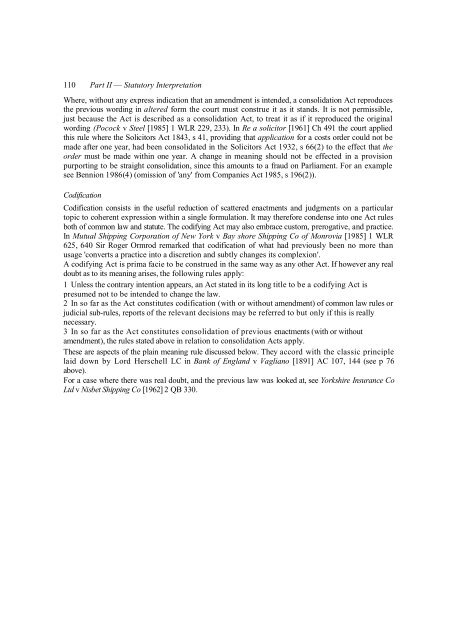Statutory Interpretation The Technique of Statutory ... - Francis Bennion
Statutory Interpretation The Technique of Statutory ... - Francis Bennion
Statutory Interpretation The Technique of Statutory ... - Francis Bennion
Create successful ePaper yourself
Turn your PDF publications into a flip-book with our unique Google optimized e-Paper software.
110 Part II — <strong>Statutory</strong> <strong>Interpretation</strong><br />
Where, without any express indication that an amendment is intended, a consolidation Act reproduces<br />
the previous wording in altered form the court must construe it as it stands. It is not permissible,<br />
just because the Act is described as a consolidation Act, to treat it as if it reproduced the original<br />
wording (Pocock v Steel [1985] 1 WLR 229, 233). In Re a solicitor [1961] Ch 491 the court applied<br />
this rule where the Solicitors Act 1843, s 41, providing that application for a costs order could not be<br />
made after one year, had been consolidated in the Solicitors Act 1932, s 66(2) to the effect that the<br />
order must be made within one year. A change in meaning should not be effected in a provision<br />
purporting to be straight consolidation, since this amounts to a fraud on Parliament. For an example<br />
see <strong>Bennion</strong> 1986(4) (omission <strong>of</strong> 'any' from Companies Act 1985, s 196(2)).<br />
Codification<br />
Codification consists in the useful reduction <strong>of</strong> scattered enactments and judgments on a particular<br />
topic to coherent expression within a single formulation. It may therefore condense into one Act rules<br />
both <strong>of</strong> common law and statute. <strong>The</strong> codifying Act may also embrace custom, prerogative, and practice.<br />
In Mutual Shipping Corporation <strong>of</strong> New York v Bay shore Shipping Co <strong>of</strong> Monrovia [1985] 1 WLR<br />
625, 640 Sir Roger Ormrod remarked that codification <strong>of</strong> what had previously been no more than<br />
usage 'converts a practice into a discretion and subtly changes its complexion'.<br />
A codifying Act is prima facie to be construed in the same way as any other Act. If however any real<br />
doubt as to its meaning arises, the following rules apply:<br />
1 Unless the contrary intention appears, an Act stated in its long title to be a codifying Act is<br />
presumed not to be intended to change the law.<br />
2 In so far as the Act constitutes codification (with or without amendment) <strong>of</strong> common law rules or<br />
judicial sub-rules, reports <strong>of</strong> the relevant decisions may be referred to but only if this is really<br />
necessary.<br />
3 In so far as the Act constitutes consolidation <strong>of</strong> previous enactments (with or without<br />
amendment), the rules stated above in relation to consolidation Acts apply.<br />
<strong>The</strong>se are aspects <strong>of</strong> the plain meaning rule discussed below. <strong>The</strong>y accord with the classic principle<br />
laid down by Lord Herschell LC in Bank <strong>of</strong> England v Vagliano [1891] AC 107, 144 (see p 76<br />
above).<br />
For a case where there was real doubt, and the previous law was looked at, see Yorkshire Insurance Co<br />
Ltd v Nisbet Shipping Co [1962] 2 QB 330.

















